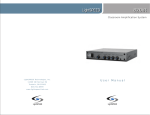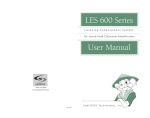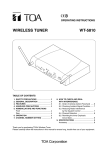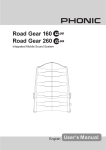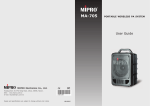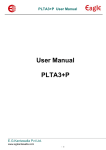Download FP 100 - Lightspeed Technologies, Inc.
Transcript
DAILY LIGHTMIC USE Infrared Wireless Microphone System START OF THE DAY Unplug the LightMic from the charging cable and place it around your neck. Adjust the neck strap so the top of the microphone rests just below your collarbone. FP 100 LightSPEED LT-71 TURN ON THE LIGHTMIC 1 2 3 4 OFF ON CHARGE BATTERIES A CH B Turn the microphone ON using the ON/OFF switch on the side of the LightMic and speak normally. Set the channel switch to A. Plug the LightMic back into the charging cable to recharge at the end of the day. Speak in a natural voice. A normal conversational speech level will provide an adequate signal. It is not necessary to increase the intensity of your voice—the audio system provides adequate amplification (approximately 5 – 10 dB) above ambient room noises. Avoid wearing jewelry that may rub or bump against the microphone. AC-MN100 L i g h tSP EED Te c hno lo gie s, Inc . 1 1 5 0 9 SW H e rman R d Tualat in, OR 9 7 0 6 2 800.732.8999 w ww. light spe e d-t e k . c o m Turn the LightMic off during private conversations with a student, parent, or other classroom visitor. You can also cover the LED lens on top of the LightMic to block the signal. Recharge batteries each night. When recharged nightly, operating time (actual usage) for the transmitters will last through a typical school day. MK-MN0010608-0 User Manual F FPP 1 0 0 U s e r M a n u a l CONGRATULATIONS! Congratulations on your purchase of the FP 100 Infrared Wireless Microphone System! This simple, yet powerful technology adds the benefits of Classroom Audio to an existing amplifier and speakers. This system will seamlessly integrate into a sophisticated A/V control system. With its small footprint, the FP 100 can mount in any discrete location— whether it is an audio visual cabinet or below-ceiling tray. The FP 100 is a compact, two-channel receiver that allows the use of up to two wireless microphones simultaneously in the classroom. A standard IR sensor provides high quality reception in rooms up to 1600 square feet. By connecting additional infrared sensors to the receiver, the coverage area can be expanded to provide optimal reception in varying room sizes and configurations. The LT-71 LightMic™ is a two-channel, rechargeable microphone that is clipped to a lavaliere cord and worn around the neck for teacher use, or it can be used as a standard handheld microphone for students to pass around when speaking. FP 100 User Manual | i FP 100 User Manual SAFETY INSTRUCTIONS 7. Power Sources—This LightSPEED CAUTION product should be connected to a power supply only of the type RISK OF ELECTRIC SHOCK DO NOT OPEN CAUTION: TO REDUCE THE RISK OF ELECTRIC SHOCK DO NOT REMOVE COVER (OR BACK) NO USER-SERVICEABLE PARTS INSIDE REFER SERVICING TO QUALIFIED PERSONNEL The lightning flash with arrowhead symbol within an equilateral triangle is intended to alert the user to the presence of uninsulated “dangerous voltage” within the product’s enclosure, that may be sufficient magnitude to constitute a risk of electric shock. The exclamation point within an equilateral triangle is intended to alert the user to the presence of important operating and maintenance (servicing) instructions in the literature accompanying the appliance. 1. Read Instructions—All the safety and operation instructions should be read before this LightSPEED product is operated. 2.Retain Instructions—The safety and operating instructions should be kept for future reference. 3. Heed Warning—All warnings on this LightSPEED product and in these instructions should be followed. 4. Follow Instructions—All operating and other instructions should be followed. 5. Water and Moisture—This LightSPEED product should not be used near water. 6. Heat—This LightSPEED product should be situated away from heat sources such as radiators, etc. ii | FP 100 User Manual described in these operation instructions or as marked on this LightSPEED product. 8. Power Cord Protection—Power supply cords should be routed so that they are not likely to be walked upon or pinched by items placed upon or against them. 9. Object and Liquid Entry—Care should be taken so that objects do not fall onto and liquids are not spilled into the inside of this LightSPEED product. 1 0. Damage Requiring Service—This LightSPEED product should be serviced only by qualified service personnel. The user should not attempt to service this LightSPEED product. 11. Prevent Electric Shock—do not use this polarized plug with an extension cord, receptacle or other outlet unless the blades can be fully inserted to prevent blade exposure. F FPP 1 0 0 U s e r M a n u a l TABLE OF CONTENTS FP 100 INFRARED WIRELESS MICROPHONE SYSTEM Safety Instructions .................................................................................................... ii System Components ................................................................................................. 1 Controls and Connections ......................................................................................... 2 Front and Top Panel Controls ................................................................................. 2 Rear Panel Controls . ................................................................................................. 3 LightMic Controls and Connections ........................................................................... 4 Optional Handheld Controls and Connections . ......................................................... 5 System Installation ................................................................................................... 6 Unpacking Your System ......................................................................................... 6 Location of the Receiver......................................................................................... 6 FP 100 Audio Connection ...................................................................................... 6 FP 100 Mixed Audio Connection ............................................................................ 8 IR Sensor Installation ................................................................................................ 9 Suspended Ceiling Mount ...................................................................................... 9 Wall/Solid Ceiling Mount ........................................................................................ 9 Finalizing Receiver Connections . ............................................................................ 10 Final Check .......................................................................................................... 10 Initial Set-Up ........................................................................................................... 11 Initial Set-Up: Optional HM-70 Handheld Mic .......................................................... 12 Charging the LightMic ............................................................................................. 13 Charging the HM-70 Handheld Mic ......................................................................... 14 Troubleshooting Guide............................................................................................. 15 Daily Use Instructions.............................................................................................. 16 Tips on Classroom Audio ......................................................................................... 17 Warranty Statement ............................................................................................... 17 System Specifications ............................................................................................. 18 Individual Components and Optional Accessories . ................................................. 19 User Notes .............................................................................................................. 20 FP 100 User Manual | iii FP 100 User Manual SYSTEM COMPONENTS FP 100 Infrared Wireless Microphone System Sensor Cable SR-70F Infrared Sensor Power Supply Charger LT-71 LightMic™ Transmitter Audio Patch Cable Helpful Hint 1 | FP 100 User Manual Optional HM-70 Handheld Microphone Keep ALL packaging materials. If the system must be returned, using the original packing material will be quick, convenient and prevent damage. FP100 User Manual CONTROLS AND CONNECTIONS 2 1 3 3 4 5 6 7 8 Front and Top Panel Controls 1. CH. A VOLUME: sets the nominal volume level of the teacher microphone (transmitter switched to CH A). Rotating the adjustment knob clockwise increases the output level. 2. CH. B VOLUME: sets the nominal volume level of the optional second microphone (transmitter switched to CH B). Rotating the adjustment knob clockwise increases the output level. 3. IR INDICATORS (IR): These lights will glow red when the corresponding transmitter is turned on and being received. This light confirms the FP 100 is receiving a steady infrared signal. 4. AF INDICATORS (IR): These lights flash green when audio (voice) from the microphone is detected. 5. DC POWER INPUT: Plug the 24V power supply into this jack. 6. CH. A AUDIO OUTPUT: This balanced audio output can be connected to a microphone or line input on a mixer/amplifier to amplify the audio signal from the CH. A transmitter. 7. CH. B / MIXED AUDIO OUTPUT: This balanced audio output sends the audio from the microphone set to CH. B. Both CH. A and CH. B transmitters (depending on the position of the B/MIX switch) are ouput to a microphone or line input on a mixer/amplifier. 8. B/MIX SWITCH: This switch determines the audio source that is output through the CH.B/ MIXED Audio Output jack. When the switch is set to ‘MIX’ (default), both the CH. A and CH. B signal are output through this jack. FP 100 User Manual | 2 FP 100 User Manual REAR PANEL CONTROLS 1 1. SENSOR SHORT: This LED glows when there is a short in one of the sensor cables. 3 | FP 100 User Manual 2 2. SENSOR INPUT: The IR sensor cable connects to the sensor input jacks. Connect additional sensors to the FP 100 to cover large or odd-shaped rooms. FP100 User Manual LIGHTMIC CONTROLS AND CONNECTIONS 4 5 1 LT-71 LT-71 6 1. ON/OFF/MUTE Switch: This switch, located on the side of the LightMic, turns the unit on or off/mute. 2. Channel Select Switch (CH A/B): This switch allows for selection between Channel A or B. If you are using a single microphone/ transmitter for your system, we recommend using Channel A. 3. Power/Charge LED Indicator: The light glows blue when the LightMic is powered ON, red when plugged into the charging cable. 2 3 5. Auxiliary (AUX): Plug a laptop, MP3 player or other audio source into this jack to wirelessly transmit the audio signal to be played through the FP 100. 6. Charger Input (CHARGER): Plug the charging cable from the FP 100 into this jack for daily charging. The LED on the front will glow red to indicate charging. 4. External Microphone Input (MIC): Use the 3.5 mm MIC jack for the optional TK-250 headset microphone (part# MC-TK250LTM). FP 100 User Manual | 4 FP 100 User Manual OPTIONAL HANDHELD CONTROLS AND CONNECTIONS 3 1 4 NiMH 6 2 5 1. ON/OFF/MUTE Switch: This switch, located on the side of the LightMic, turns the unit ON or OFF/MUTE. 2. Channel Select Switch (CH A/B): Located in the battery compartment, the switch is set to Channel B at the factory. 3. Power/Charge LED Indicator: The light glows red when the LightMic is powered ON. 4. Charger Input (CHARGER): Plug the charger into this jack for daily charging. The LED on the front will glow red to indicate charging. 5 | FP 100 User Manual 5. Infrared Emitters: Avoid covering the emitters as you grip the HM-70 or this could interrupt signal transmission from the microphone to the receiver. 6. Volume Gain Switch: Located in the battery compartment, microphone volume can be increased by gently turning the screw. Optimum volume level is pre-set at the factory and no adjustment should be necessary. FP100 User Manual SYSTEM INSTALLATION Unpacking Your System Location of the Receiver Ensure that you have received all of the components of your system. Place the FP 100 on a flat surface like a cabinet, shelf, or tray. • FP 100 Receiver and power • Select a location that is close to a standard wall electrical outlet. supply • LT-71 LightMic™ Transmitter • SR-70F Infrared Sensor and cable • Transmitter Wall Charger • Sensor Cable will be routed back to the receiver, so select a location that is free from obstructions that may make routing wire difficult. (Example: under a whiteboard or bulletin board.) • Audio Patch Cable FP 100 Audio Connection 1. Locate the audio patch cable 2. Strip the cable’s rubber insulation ½” and then strip the outer sheath of the signal wire leaving ¼” exposed. FP 100 User Manual | 6 FP 100 User Manual SYSTEM INSTALLATION (cont’d) 3. Insert the stripped wires into the marked openings, left and right, in the Euro-block. Euro-block 4. Secure the inserted wires by tightening the retaining screws. 7 | FP 100 User Manual FP100 User Manual SYSTEM INSTALLATION (cont’d) 4. Ensure the B/MIX switch is pushed to the right to select the MIXED output. 5. Connect the ¼˝ connector into the audio or microphone input on the existing amplifier. FP 100 Mixed Audio Connection (Not Recommended) This method allows for individual control of each microphone channel from the amplifier being used. a. Obtain a second balanced audio cable. b. Strip the wire to reveal the positive, negative, and grounded conductors. c. Fasten the wire to the available CH A euro-block connector using a small screw driver (observe the proper polarity). FP 100 User Manual | 8 FP 100 User Manual IR SENSOR INSTALLATION Sensor Placement in the Classroom Sensor location is very important for optimum performance of the FP 100 IR Wireless Microphone System. • BEST: On the ceiling at or near the middle of the classroom. < GOOD < BEST • GOOD: High and centered on the long wall. • AVOID: Locations in corners, on walls at heights lower than 7 feet, or in places where the signal could be obstructed. Suspended Ceiling Mount Wall/Solid Ceiling Mount wall mounting strip c-clip sensor jack 1. Lift the ceiling tile nearest the grid rail in your desired sensor location. Guide one side of the C-clip over one edge of the grid rail. Providing firm support to the back of the grid rail with one hand (to prevent bending), firmly and carefully snap the second side of the C-clip over the edge of the rail. 2. Uncoil sensor wire. Connect one end of the sensor cable to the plug on the sensor. Loosely secure wire overhead and route it back to the FP 100. 3. Connect the other end of the sensor cable into one of the sensor inputs on the back of the FP 100. 9 | FP 100 User Manual 1. Screw the plastic mounting strip to a place high on the wall or in the middle of the solid ceiling. Mount the strip horizon tally as shown above. 2. Firmly snap the C-clip on the back of the IR sensor onto the plastic mounting strip with the sensor plug hanging down (if a wall mount) or toward the receiver location (if ceiling mount). 3. Uncoil the sensor wire. Screw one end of the sensor cable to the plug on the sensor. Route the wire back to the FP 100, securing it along the way. 4. Connect the other end of the sensor cable to one of the sensor inputs on the FP 100. FP100 User Manual FINALIZING RECEIVER CONNECTIONS 1. Ensure all top panel volume controls are turned fully counterclockwise. 3. Ensure sensor cable is attached 2. Ensure audio output connection(s) are securely connected into the FP 100 and the mixer/amplifier. Make sure the CH.B/MIX switch is in the appropriate setting based on your output method (see pg. 11 for more info). 4. Ensure DC barrel end of the power supply is connected to the DC input on the FP 100. securely. 5. Ensure AC adaptor end of the power supply is connected to a standard 110 VAC electrical wall outlet. FINAL CHECK 1. Ensure all cables are appropriately routed out of walking paths and work areas to prevent safety hazards to individuals in the room. 2. The receiver packing material should be kept for warranty shipping purposes. Dispose of remaining system-packing material in the appropriate refuse containers. Leave microphones charging so they are ready for use. Microphones will need to be charged on a daily basis. FP 100 User Manual | 10 FP 100 User Manual INITIAL SET-UP 1. Slip the LT-71 LightMic with lanyard around your neck and position the top of the microphone just below your collarbone. Positioning of the LightMic is critical for proper volume adjustment. 2. Turn on the LightMic and set the operating channel to “A.” This microphone will be designated as the “Teacher Mic.” 3. Set the volume on the mixer/amplifier at a normal level. This will be the primary control the teacher will use to turn the microphone volume(s) up and down. 4. While speaking in a normal voice, increase the A VOLUME level until your own voice is barely audible. Remember: this equipment is designed to supplement and distribute the teacher’s voice so he or she is able to speak at a normal, conversational tone. Having the volume set too high will result in feedback and listener fatigue. 5. If a second student pass-around microphone was purchased, set the volume level for that transmitter as indicated above, using the B VOLUME control. 6. Once the normal level is set on the FP 100, the user will now use the mixer/amplifier volume control to adjust the >> microphone up or down during normal classroom operation. 11 | FP 100 User Manual FP100 User Manual INITIAL SET-UP: OPTIONAL HM-70 HANDHELD MIC ON OFF MUTE (Center Position) 1. Slide the power switch on the side 3. Grip the barrel of the HM-70 in the of the HM-70 all the way up. The power indicator LED will glow red and stay on. 2. The center position of the power switch is MUTE. When in this mode, the HM-70 is transmitting a signal, but no audio can be heard through the system. This is useful if you wish to temporarily turn audio off during a private conversation. center section just below the power switch. Avoid gripping the HM-70 around the bottom, covering the infrared emitters circling the base. This could interrupt signal transmission from the microphone to the receiver. 4. Speak directly into the microphone at a normal level. Slowly increase the B VOLUME until you can just hear your voice. 5. Slide the switch to the OFF position to turn off the HM-70. (Make sure the power indicator light is off.) The Channel A/B switch is located inside the battery compartment. The switch is set to Channel B at the factory. FP 100 User Manual | 12 FP 100 User Manual CHARGING THE LIGHTMIC 1. Ensure that the LightMic is turned OFF. 2. Make sure the wall charger is plugged into a wall outlet. Connect one of the charging plugs into the jack labeled CHARGER on the side of the LT-71. The LT-71’s rechargeable batteries are factory installed. The LED on the front of the LightMic will glow red when charging. 3. Leave the LightMic plugged in overnight (8–10 hrs.) to obtain a full charge. Helpful Hint Do not attempt to charge alkaline batteries. They can overheat and expand, creating a significant hazard and damaging the LightMic. (This is not covered by the warranty.) 13 | FP 100 User Manual FP100 User Manual CHARGING THE HM-70 HANDHELD MIC 3. The power indicator light next to 1. Ensure the HM-70 handheld microphone is turned OFF (ON/OFF switch on the side of the unit). 2. Make sure the wall charger is plugged into an electrical outlet. Connect one of the charging plugs into the jack labeled CHARGER on the side of the HM-70. The HM-70’s rechargeable batteries are factory installed. Helpful Hint the power switch glows green when the cable is connected and charging correctly. The light goes out when fully charged. Batteries will charge in 8 to 12 hours. A fully charged battery will run for up to 8 hours of continuous operation. All LightSPEED microphone transmitters can remain charging for up to 10 days. Overcharging will not create a hazard, but will shorten battery life. FP 100 User Manual | 14 FP 100 User Manual TROUBLESHOOTING GUIDE Note: Most problems are directly related to low battery power. Please run through the “Battery Check” items first. For remaining troubleshooting, use known good, fully-charged batteries. Battery Check •Confirm batteries are charged each night. •Make sure the LT-71 is turned off while charging so that it will attain a full charge. Full charge will last eight hours. •Make sure the charge cord is connected to the cradle charger. •Inspect the battery contacts. Clean and adjust if necessary. Hearing Static •Ensure sensor is in optimum location (refer to sensor placement in manual). A single sensor will cover a 1600 sq. ft. enclosed classroom. •Ensure that no other LT71/HM70 is operating on the same channel. • If an external microphone is in use, try another LightMic that is known to be working (if available) to isolate the problem. If static persists with “known good” microphone, the LT-71 input jack has damage and will need service. Low Volume or Feedback • Ensure microphone is positioned appropriately, just below the collar bone. If a headset microphone is in use, the end of the mic boom should be positioned at the corner of the mouth. •Check volume level on the amplifier/ mixer (or wall-mounted controller). If the volume is set too high, feedback WILL occur—adjust accordingly. •Check volume levels on the FP 100. The screwdriver adjust controls should be set at a normal level so that volume is appropriate for the classroom when the corresponding mixer/amplifier volume level is at mid-range. Adjust the levels up or down accordingly. No Sound •Confirm the transmitter is on as indicated by a Blue LED on the LightMic or a Red LED on the HM-70 Handheld mic. •Confirm signal is being received at the FP 100. The IR signal light will be lit (red) indicating a signal is being received. • Confirm microphone is functioning. Next to the IR signal light is the AF signal light. This light will flicker (green) as audio is picked up by the microphone indicating activity. •Ensure the IR sensor is receiving power as indicated by a red LED on one side of the unit—this should be easily visible from the ground. •If no indicator lights are present on the FP 100, ensure it is receiving power. Unplug the DC power jack and re-connect. If the receiver is receiving power, the IR and AF lights will flash on when reconnected to a power source. •Ensure the separate mixer/amplifier is operating properly as a standalone system. If you review these instructions and still have questions, write down the serial number and model number of your system and call LightSPEED Technical Services at 800.732.8999, 5 a.m. – 5 p.m. PST. 15 | FP 100 User Manual FP100 User Manual DAILY USE INSTRUCTIONS POSITION THE LIGHTMIC Unplug the LightMic from the charger and place it around your neck. Adjust the neck strap so the top of the microphone rests just below your collarbone. TURN ON THE LIGHTMIC Turn the microphone ON using CHARGE BATTERIES the ON/OFF switch on the side of Plug the LightMic into the Wall Charger the LightMic to recharge at the end of the day. and speak nor- OFF A CH B to A. ON mally. Set the channel switch FP 100 User Manual | 16 FP 100 User Manual TIPS ON CLASSROOM AUDIO 1 2 3 4 Speak in a natural voice. A normal conversational speech level will provide an adequate signal. It is not necessary to increase the intensity of your voice—the audio system provides adequate amplification (approximately 5 – 10 dB) above ambient room noises. Avoid wearing jewelry that may rub or bump against the microphone. Turn the LightMic off during private conversations with a student, parent, or other classroom visitor. You can also cover the LED lens on top of the LightMic to block the signal. Recharge batteries each night. When recharged nightly, operating time (actual usage) for the transmitters will last through a typical school day. Five-year Limited Warranty LightSPEED Classroom Audio Systems are guaranteed against malfunction due to defects in materials and workmanship for a period of FIVE (5) YEARS, beginning at the date of the purchase invoice. If such malfunction occurs, the product will be repaired or replaced (at LightSPEED’s option) without charge during the warranty period. 1. Warranty on infrared microphones is FIVE (5) YEARS. 2. Warranty on LightSPEED NH1 AA rechargeable batteries, all external cables and wires provided by LightSPEED is one (1) year. 3. Prepaid shipping labels are provided by LightSPEED factory or an authorized warranty service center for warranty repairs. 4. Warranty does not extend to finish, appearance items, or malfunctions due to abuse or operation other than specified conditions, nor does it extend to incidental or consequential damages. Repair by other than LightSPEED or its authorized service agencies will void this guarantee. Information on authorized service agencies is available from LightSPEED Technologies, Inc. Our Service Department (800.732.8999, 5 a.m. – 5 p.m., PST) will handle all your repair/replacement needs. 17 | FP 100 User Manual FP100 User Manual SYSTEM SPECIFICATIONS OVERALL SPECIFICATIONS Standard Carrier Frequencies (IR) Alternative Carrier Frequencies (IR) Frequency Stability Maximum Deviation Dynamic Range Signal-to-Noise Ratio Frequency Response 2.06/2.54 MHz 3.2/3.7 MHz ± 3% ±50 Hz > 73 dB > 73 dB 100 Hz – 10 kHz Audio Output Level 0 – 1.0 V RECEIVER SPECIFICATIONS Receiver Type Receiver Sensitivity Image and Spurious Rejection Reception Selectivity Squelching Mute Level Sensor Inputs (F-connector) Sensor Short Indicator Power Supply (UL Listed) Weight Dimensions (W x D x H) Superheterodyne 6 µV for 60 dB S/N > 70 dB 40 kHz 3.2 µV 2 Input Yes 24 V / 250 mA TRANSMITTER SPECIFICATIONS Audio Distortion Built-in Microphone Battery Power (1-year warranty) Inputs Dimensions (W x D x H) Weight <1% Unidirectional Electret 2 AA NiMH Rechargeable Mic Level 3.5 mm Line Level 3.5 mm 1.375” x .75” x 4.625” 3.7 oz. IR SENSOR SPECIFICATIONS Working Range Cable Mounting Dimensions Weight Up to 1600 square feet 6 ft./50 ft., Plenum-rated Ceiling clip/Wall bracket 4.25” (Diam.) x 2.0” (H) 4.5 oz. FP 100 User Manual | 18 FP 100 User Manual INDIVIDUAL COMPONENTS & OPTIONAL ACCESSORIES Part Number Description RX-FP100 Infrared microphone receiver LT71 LightMic rechargeable microphone/transmitter w/lavaliere cord, batteries and charging cable BA-NH1 Rechargeable AA battery (Nickel Metal Hydride) AC-LTCB Lavaliere cord for LT-71 PS-24V-250 Power supply SR70F Infrared sensor with cable and wall or ceiling mounting bracket BC-TXLT Wall Charger Optional Accessories HM70 AC-71CC Handheld microphone/transmitter w/batteries and charging cable Cradle charger MC-TK250LTM Noise-canceling headset microphone to be used with LT-71 SPEAKERS Contact LightSPEED at 800.732.8999 for loudspeaker information 19 | FP 100 User Manual FP100 User Manual USER NOTES Record your system serial numbers and purchase information. This is helpful when ordering additional components, accessories, and/or warranty service. Components Serial Number FP 100 Microphones Sensors Speakers Purchase Information Your School/Organization District Purchase Date Invoice FP 100 User Manual | 20 FP 100 User Manual USER NOTES 21 | FP 100 User Manual DAILY LIGHTMIC USE Infrared Wireless Microphone System START OF THE DAY Unplug the LightMic from the charging cable and place it around your neck. Adjust the neck strap so the top of the microphone rests just below your collarbone. FP 100 LightSPEED LT-71 TURN ON THE LIGHTMIC 1 2 3 4 OFF ON CHARGE BATTERIES A CH B Turn the microphone ON using the ON/OFF switch on the side of the LightMic and speak normally. Set the channel switch to A. Plug the LightMic back into the charging cable to recharge at the end of the day. Speak in a natural voice. A normal conversational speech level will provide an adequate signal. It is not necessary to increase the intensity of your voice—the audio system provides adequate amplification (approximately 5 – 10 dB) above ambient room noises. Avoid wearing jewelry that may rub or bump against the microphone. AC-MN100 L i g h tSP EED Te c hno lo gie s, Inc . 1 1 5 0 9 SW H e rman R d Tualat in, OR 9 7 0 6 2 800.732.8999 w ww. light spe e d-t e k . c o m Turn the LightMic off during private conversations with a student, parent, or other classroom visitor. You can also cover the LED lens on top of the LightMic to block the signal. Recharge batteries each night. When recharged nightly, operating time (actual usage) for the transmitters will last through a typical school day. MK-MN0010608-0 User Manual




























